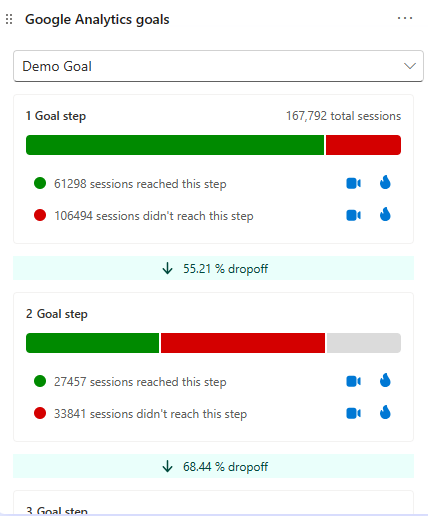What Data Is Google Analytics Goals Unable to Track: A Total Guide
What Data Is Google Analytics Goals Unable to Track: A Total Guide
Blog Article
Introducing the Blind Spots: Comprehending What Google Analytics Goals Can not Determine
In the world of electronic analytics, Google Analytics stands as an effective tool for monitoring and assessing on the internet user communications. Recognizing what Google Analytics goals can not gauge is crucial for obtaining a detailed view of individual actions and interaction.
User Actions on External Platforms
Recognizing exactly how users connect on outside systems is important for optimizing on-line techniques. Exterior platforms, such as social media networks, reference internet sites, and on-line discussion forums, play a substantial function in driving traffic to a company's website. By assessing user behavior on these platforms, companies can acquire useful understandings right into the performance of their advertising initiatives and the choices of their target audience.
One trick element of customer behavior on outside platforms is the recommendation source. By tracking where the customers are originating from, companies can recognize which platforms are driving the most traffic to their internet site. This information can assist firms assign their sources better, concentrating on the systems that yield the ideal outcomes.
Offline Conversions and Communications
Assessing customer actions on exterior systems gives valuable understandings right into online techniques; however, thinking about offline conversions and interactions is equally necessary for a thorough understanding of a business's general performance. While Google Analytics excels at tracking on-line communications, it falls short in capturing the full consumer trip that commonly consists of offline touchpoints. Offline conversions, such as in-store acquisitions or phone queries, play a considerable role in numerous companies' success. Neglecting these communications can lead to an altered sight of the effectiveness of advertising campaigns and overall company efficiency.

Attribution Beyond Last Click
When delving into the world of electronic marketing analytics, it ends up being important to look beyond the solitary touchpoint of the last click for an extra extensive understanding of acknowledgment. While Google Analytics gives important understandings right into individual behavior, depending exclusively on last-click acknowledgment can be restricting - what data is google analytics goals unable to track. Acknowledgment versions that exceed the last click offer a more nuanced view of the client journey, taking into consideration all the touchpoints that cause a conversion
Attribution beyond the last click allows marketing professionals to appoint credit to various interactions along the conversion path, giving a clearer image of the efficiency of various advertising and marketing networks. By discovering multi-touch acknowledgment versions such as linear, time decay, or position-based attribution, services can much better designate their marketing budget plans and enhance their methods for maximum effect.
Understanding the influence of each touchpoint in the conversion process is important for making informed choices and making the most of ROI. By embracing acknowledgment beyond the last click, companies can obtain much deeper insights into consumer actions and tailor their marketing initiatives better.
Cross-Device and Cross-Browser Monitoring

Similarly, cross-browser tracking complements cross-device tracking by catching individual actions as they switch over between different web browsers. Recognizing just how customers interact with sites on different web browsers can aid online marketers enhance their on the internet experiences to make certain consistency and performance throughout various systems.
Qualitative Information and Customer Intent
Recognizing user intent with qualitative data evaluation is vital for developing targeted digital marketing approaches that resonate with the requirements and choices of the target market. Qualitative information offers understandings right into the 'why' behind individual actions, clarifying inspirations, feelings, and choices that quantitative data alone can not catch. By analyzing user responses, comments, and communications, important source marketers can reveal valuable information concerning individual intent, enabling them to tailor their messaging, content, and offerings to much better line up with what their audience is looking for.
Qualitative information also helps in recognizing the context in which individuals engage with a website or app. This contextual understanding makes it possible for marketing professionals to produce more appropriate and customized experiences, eventually driving higher interaction and conversion rates. By diving right into individual intent through qualitative information analysis, companies can gain a much deeper understanding of their target audience, click to find out more leading to a lot more efficient marketing approaches that fulfill customers' needs and expectations.
Conclusion
Finally, Google Analytics objectives have limitations in gauging user habits on exterior systems, offline conversions, acknowledgment beyond last click, cross-device and cross-browser tracking, and qualitative information related to individual intent. what data is google analytics goals unable to track. It is necessary for organizations to be aware of these dead spots in order to supplement their information analysis with various other devices and methods to get an extra extensive understanding of their target market and boost their overall digital advertising methods
By analyzing individual actions on these systems, businesses can acquire beneficial insights into the efficiency of their advertising and marketing initiatives and the preferences of their target audience.
Assessing customer behavior on outside systems provides useful understandings into on the internet approaches; however, considering offline conversions and interactions is just as imperative for a comprehensive understanding of a company's overall efficiency.In digital advertising and marketing analytics, moving past last-click attribution to discover dig this cross-device and cross-browser monitoring is vital for obtaining a holistic understanding of individual communications throughout different systems and tools. By evaluating customer feedback, comments, and interactions, marketers can reveal beneficial information about user intent, allowing them to tailor their messaging, material, and offerings to better line up with what their audience is seeking.
By delving right into customer intent through qualitative information analysis, businesses can acquire a deeper understanding of their target audience, leading to more efficient advertising methods that satisfy users' needs and expectations.
Report this page